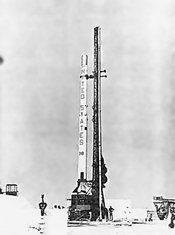Mercury-Scout 1
|
|
| Mission Insignia | |
|---|---|

| |
| Mission Statistics | |
| Mission Name: | Mercury MS-1 |
| Call Sign: | MS-1 |
| Number of Crew Members: | 0 |
| Launch: | November 1, 1961 15:32 UTC Cape Canaveral Complex 18B |
| Landing: | November 1, 1961 UTC |
| Duration: | 44 seconds |
| Number of Orbits: | 0 |
| Apogee: | 0 km |
| Perigee: | 0 km |
| Period: | 0 m |
| Inclination: | 0 deg |
| Distance Traveled: | 0 km |
| Peak acceleration: | 7.6 g (74.5 m/s²) |
| Mass: | 67.5 kg |
| Mercury-Scout | |
| Mercury Scout 1 | |
On May 5, 1961 NASA issued a Mercury program proposal document to use Scout rockets to launch small satellites that would evaluate the worldwide Mercury Tracking Network in preparation for manned orbital missions. The first of these satellites would be called Mercury-Scout 1 (MS-1).
The Mercury Tracking Network were a series of U.S. owned and operated ground stations and tracking ships, positioned around the world under the flightpath of the Mercury spacecraft. When the Mercury spacecraft came within several hundred miles of a ground station, it could have line of sight voice and telemetry communications by HF, VHF or UHF radio and C-band and S-band radar. These communications passes would only last a few minutes, until the ground station disappeared over the horizion. Between ground stations, the Mercury spacecraft was out of communications, except of an occasional unreliable HF message. In the early 1960's there were no synchronous communications satellites. The ground stations were linked back to NASA Mercury Control through land lines, under sea cables and in some cases HF (shortwave) radio.
The concept was approved on May 24. On June 13 the NASA Space Task Group issued requirements for a modified Scout rocket and small communications satellite, that became known as Mercury-Scout.
The USAF Blue-Scout rocket would launch the small communications satellite (MS-1) into orbit. The small satellite would simulate a Mercury spacecraft, allowing testing and training of the Mercury Tracking Network.
The 67.5 kg MS-1 communications satellite was shaped like a small rectangular box. Within the box, electronics consisted of two command receivers, two minitrack beacons, two telemetry transmitters, an S- and C-band beacon and antennas; all powered by a 1500 watt-hour battery. Also attached was the 4th stage insturment package. The battery could power the electronics for 18.5-hours before running down. To extend the satellite life, the equipment would be powered off by a ground command after the first three orbits (5-hours). During powerdown, data results would be analyzed. The satellite would then be powered up for another three orbits (5 more hours). This process would then be repeated a third time. Mercury planners thought that by shutting down and powering up the satellite, the Mercury Tracking Network would get data and experience from the equivalent of three Mercury orbital missions.
NASA decided to modify a USAF Blue Scout II, # D-8, for the first Mercury-Scout mission. The U. S. Air Force was already launching Blue Scout rockets from Cape Canaveral and launched this one as well.
Mercury-Scout 1 was launched on the USAF Blue Scout II, # D-8 on November 1, 1961, from Cape Canaveral Launch Complex 18B. Twenty-eight seconds after being liftoff, the Blue Scout II first stage failed. The rocket was destroyed by the Range Safety Officer after 44 seconds of flight.
NASA Mercury program managers cancelled any further Mercury-Scout missions. They were no longer needed. By the time Mercury-Scout 1 was launched, the MA-4 and MA-5 missions had already orbited Mercury spacecraft and checked out the Mercury Tracking Network.
Blue Scout II Parameters
| Parameter | 1st Stage | 2nd Stage | 3rd Stage | 4th Stage |
|---|---|---|---|---|
| Gross Mass | 10,705 kg | 4,424 kg | 1,225 kg | 238 kg |
| Empty Mass | 1,900 kg | 695 kg | 294 kg | 30 kg |
| Thrust | 470 kN | 259 kN | 60.5 kN | 12.4 kN |
| Isp | 214 s (2.10 kNs/kg) | 262 s (2.57 kNs/kg) | 256 s (2.51 kNs/kg) | 256 s (2.51 kNs/kg) |
| Burn time | 40 s | 37 s | 39 s | 38 s |
| Length | 9.12 m | 6.04 m | 3.38 m | 1.83 m |
| Diameter | 1.01 m | 0.79 m | 0.78 m | 0.46 m |
| Engine: | Aerojet General Algol 1 | Thiokol XM33 (TX-354-3) Castor 2 | Allegany Ballistics Lab X-254 Antares 1A | Allegany Ballistics Lab X-248 Altair 1 |
| Propellant | Solid Fuel | Solid Fuel | Solid Fuel | Solid fuel |
Blue Scout II rocket Length: 21.65 m (11 in); diameter: 1.02 m, Finspan: 2.84 m
LEO Payload: 30 kg. to: 300 km Orbit. at: 28.0 degrees. Apogee: 2,500 km.
| Previous Mission: Mercury-Atlas 4 | Mercury | Next Mission: Mercury 5 |

